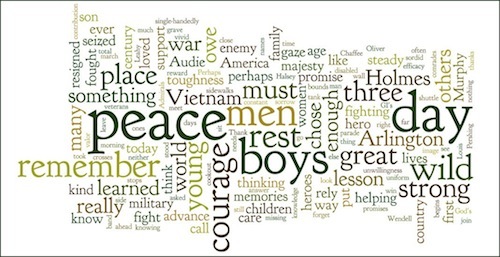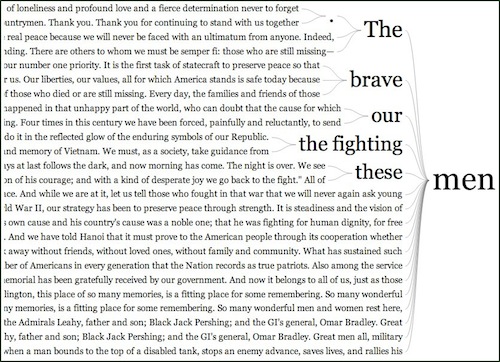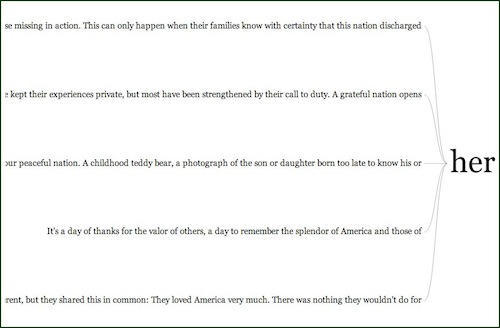

In 1980, Ronald Reagan gave a stump speech at the Veterans of Foreign Wars Convention. There, he addressed an issue that politicians at the time did not like to broach — the Vietnam War. Rather than avoiding discussions about Vietnam, he called it a "noble cause," and urged Americans to move beyond the "Vietnam Syndrome." This speech was an initial factor in getting Americans to talk about and confront what had happened in Vietnam, crediting Reagan for the creation of a historical memory of the war based on veteran sacrifice.
Reagan's rhetoric focused largely on what veterans gave up in order to serve during the Vietnam War. However, his speeches exclusively discuss what male veterans sacrificed. As these visualizations show, women were only referenced generically toward the end of Reagan's presidency, when he says "men and women." However, he gave specific examples of male veteran sacrifice and consistently used masculine terms when mentioning sacrifice. The visualizations on this page show the language Reagan used, and how it created a memory that excluded female veterans from the history of the Vietnam War.

This word cloud uses the language from six of Reagan's speeches directly about the Vietnam War to show how his rhetoric is gendered. The larger the word appears in the cloud, the more frequently the word was used. While "men" is one of the larger words in the cloud, "women" is very small and barely noticeable. In addition, male terminology including the words "boys" and "sons" are pictured in the cloud, while female terminology is not pictured.
In addition, words that describe veteran sacrifice like "courage," "honor," and "freedom" are prominently featured in the cloud. It depicts Reagan's emphasis on creating the historical memory of the Vietnam War that encompassed these themes, and moved away from the feelings of failure previously associated with the war. Through the use of this language, Reagan was largely able to change American opinion about the Vietnam War. Not only did he associate the war with veteran sacrifice, but he also marginalized women from its memory.

The word trees show how different words are used in the context of the same six of Reagan's speeches about Vietnam. Throughout Reagan's speeches, the word "men" was used 28 times, compared to the six times "women" was used, and "women" was only used in conjunction with "men." The tree demonstrates how "men" is used in each sentence. It is commonly used with words like "brave," "fighting," "great," and "service." These words demonstrate how veteran sacrifice became the focus of Reagan's speeches. With an emphasis on veteran sacrifice, it was necessary for Reagan to uphold traditional gender roles because it demonstrates how women and men should be differentiated in war. Despite the fact that all women who served in Vietnam did so voluntarily, Reagan does not call attention to female veteran's fulfillment of civic duty. The tree also shows how these words are only used when addressing the service of men.

The most prominent use of feminized rhetoric came in reference to America as "her," demonstrated by the word tree. By feminizing the country, Reagan was able to achieve two goals in creating a collective memory of the Vietnam War. He feminized the country to show that its ideals were something to be fought for and protected. This made the country the victims, rather than the aggressors of the Vietnam War, and helped promote the "noble cause" ideology. It also solidifies gender roles by demonstrating that a feminized nation was protected by male veterans. Rather than complicating the Vietnam War narrative by saying that female veterans could protect a feminized nation, Reagan used these terms to define roles for men and women in war.